Media Portfolio: Racism's Impact on Indigenous Australians Health
VerifiedAdded on 2020/04/15
|15
|4431
|85
Report
AI Summary
This report, titled "Media portfolio: the impact of racism on indigenous australians relating to suicide and mental illness," examines the detrimental effects of racism on the mental health and suicide rates of Indigenous Australians. The introduction highlights the historical health disparities faced by Indigenous communities, emphasizing the role of social and economic factors, particularly racism. The report analyzes four media articles from various sources, each addressing the impact of racism on Indigenous mental health. Each article's relevance to the unit's topics, its impact on the related topic, and a personal reflection are provided. The articles discuss government failures in addressing Indigenous health needs, the prevalence of mental illness among young Indigenous people, and tragic cases of youth suicide linked to abuse, neglect, and racism. The report concludes by emphasizing the urgent need for systemic changes to address the ongoing issues of racism and its devastating impact on Indigenous communities. The references section includes the sources cited in the report.

0Running head: INDIGENOUS HEALTH PERSPECTIVE
Indigenous Health Perspective
MEDIA PORTFOLIO: THE IMPACT OF RACISM ON INDIGENOUS AUSTRALIANS
RELATING TO SUICIDE AND MENTAL ILLNESS
Indigenous Health Perspective
MEDIA PORTFOLIO: THE IMPACT OF RACISM ON INDIGENOUS AUSTRALIANS
RELATING TO SUICIDE AND MENTAL ILLNESS
Paraphrase This Document
Need a fresh take? Get an instant paraphrase of this document with our AI Paraphraser
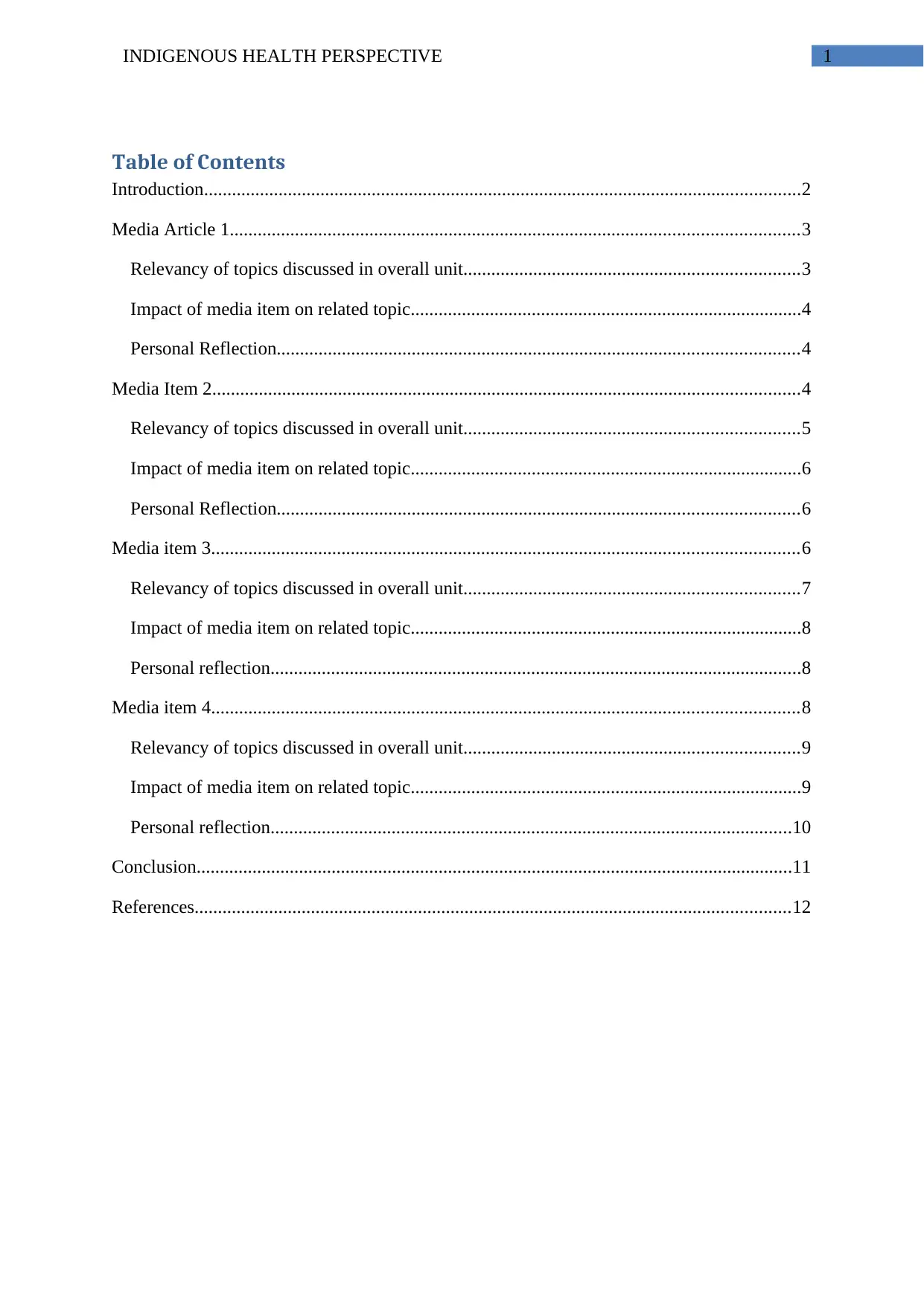
1INDIGENOUS HEALTH PERSPECTIVE
Table of Contents
Introduction................................................................................................................................2
Media Article 1..........................................................................................................................3
Relevancy of topics discussed in overall unit........................................................................3
Impact of media item on related topic....................................................................................4
Personal Reflection................................................................................................................4
Media Item 2..............................................................................................................................4
Relevancy of topics discussed in overall unit........................................................................5
Impact of media item on related topic....................................................................................6
Personal Reflection................................................................................................................6
Media item 3..............................................................................................................................6
Relevancy of topics discussed in overall unit........................................................................7
Impact of media item on related topic....................................................................................8
Personal reflection..................................................................................................................8
Media item 4..............................................................................................................................8
Relevancy of topics discussed in overall unit........................................................................9
Impact of media item on related topic....................................................................................9
Personal reflection................................................................................................................10
Conclusion................................................................................................................................11
References................................................................................................................................12
Table of Contents
Introduction................................................................................................................................2
Media Article 1..........................................................................................................................3
Relevancy of topics discussed in overall unit........................................................................3
Impact of media item on related topic....................................................................................4
Personal Reflection................................................................................................................4
Media Item 2..............................................................................................................................4
Relevancy of topics discussed in overall unit........................................................................5
Impact of media item on related topic....................................................................................6
Personal Reflection................................................................................................................6
Media item 3..............................................................................................................................6
Relevancy of topics discussed in overall unit........................................................................7
Impact of media item on related topic....................................................................................8
Personal reflection..................................................................................................................8
Media item 4..............................................................................................................................8
Relevancy of topics discussed in overall unit........................................................................9
Impact of media item on related topic....................................................................................9
Personal reflection................................................................................................................10
Conclusion................................................................................................................................11
References................................................................................................................................12

2INDIGENOUS HEALTH PERSPECTIVE
Introduction
The health drawbacks faced by indigenous peoples in Australia is centuries old,
before 1788, the indigenous Australians enjoyed healthy lives than most Europeans
(HealthInforNet, 2017). After the arrival of British, this situation changes and currently
indigenous communities are more vulnerable towards diseases than others. There are several
social, economic factors which have increases health disadvantages in indigenous peoples
such as unemployment, the absence of health care and lack of lands (Knibbs & Sly, 2014).
One of the leading causes of suicide and mental illness in indigenous peoples is racism
(Priest, Paradies, Gunthorpe, Cairney, & Sayers, 2011).
This report will discuss regarding the impact of racism on the mental health and
suicide rate of indigenous peoples in Australia. Due to racism, indigenous people face various
social discriminations and abuses which resulted in mental illnesses and psychological
problems that encourage peoples to commit suicide. This report will evaluate four recent
media articles from multiple sources which are based on the effect of racism on mental health
of indigenous peoples.
Introduction
The health drawbacks faced by indigenous peoples in Australia is centuries old,
before 1788, the indigenous Australians enjoyed healthy lives than most Europeans
(HealthInforNet, 2017). After the arrival of British, this situation changes and currently
indigenous communities are more vulnerable towards diseases than others. There are several
social, economic factors which have increases health disadvantages in indigenous peoples
such as unemployment, the absence of health care and lack of lands (Knibbs & Sly, 2014).
One of the leading causes of suicide and mental illness in indigenous peoples is racism
(Priest, Paradies, Gunthorpe, Cairney, & Sayers, 2011).
This report will discuss regarding the impact of racism on the mental health and
suicide rate of indigenous peoples in Australia. Due to racism, indigenous people face various
social discriminations and abuses which resulted in mental illnesses and psychological
problems that encourage peoples to commit suicide. This report will evaluate four recent
media articles from multiple sources which are based on the effect of racism on mental health
of indigenous peoples.
⊘ This is a preview!⊘
Do you want full access?
Subscribe today to unlock all pages.

Trusted by 1+ million students worldwide
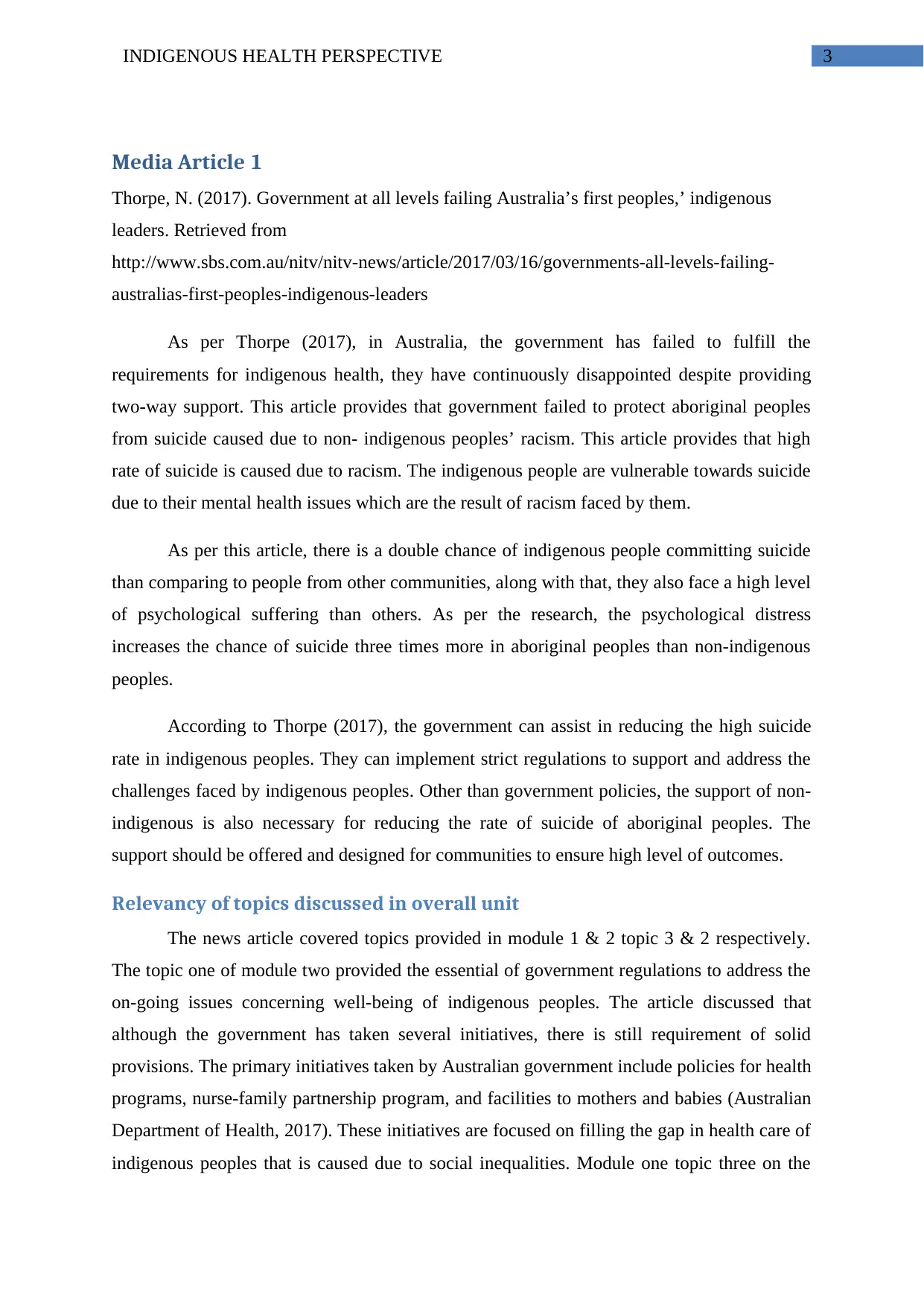
3INDIGENOUS HEALTH PERSPECTIVE
Media Article 1
Thorpe, N. (2017). Government at all levels failing Australia’s first peoples,’ indigenous
leaders. Retrieved from
http://www.sbs.com.au/nitv/nitv-news/article/2017/03/16/governments-all-levels-failing-
australias-first-peoples-indigenous-leaders
As per Thorpe (2017), in Australia, the government has failed to fulfill the
requirements for indigenous health, they have continuously disappointed despite providing
two-way support. This article provides that government failed to protect aboriginal peoples
from suicide caused due to non- indigenous peoples’ racism. This article provides that high
rate of suicide is caused due to racism. The indigenous people are vulnerable towards suicide
due to their mental health issues which are the result of racism faced by them.
As per this article, there is a double chance of indigenous people committing suicide
than comparing to people from other communities, along with that, they also face a high level
of psychological suffering than others. As per the research, the psychological distress
increases the chance of suicide three times more in aboriginal peoples than non-indigenous
peoples.
According to Thorpe (2017), the government can assist in reducing the high suicide
rate in indigenous peoples. They can implement strict regulations to support and address the
challenges faced by indigenous peoples. Other than government policies, the support of non-
indigenous is also necessary for reducing the rate of suicide of aboriginal peoples. The
support should be offered and designed for communities to ensure high level of outcomes.
Relevancy of topics discussed in overall unit
The news article covered topics provided in module 1 & 2 topic 3 & 2 respectively.
The topic one of module two provided the essential of government regulations to address the
on-going issues concerning well-being of indigenous peoples. The article discussed that
although the government has taken several initiatives, there is still requirement of solid
provisions. The primary initiatives taken by Australian government include policies for health
programs, nurse-family partnership program, and facilities to mothers and babies (Australian
Department of Health, 2017). These initiatives are focused on filling the gap in health care of
indigenous peoples that is caused due to social inequalities. Module one topic three on the
Media Article 1
Thorpe, N. (2017). Government at all levels failing Australia’s first peoples,’ indigenous
leaders. Retrieved from
http://www.sbs.com.au/nitv/nitv-news/article/2017/03/16/governments-all-levels-failing-
australias-first-peoples-indigenous-leaders
As per Thorpe (2017), in Australia, the government has failed to fulfill the
requirements for indigenous health, they have continuously disappointed despite providing
two-way support. This article provides that government failed to protect aboriginal peoples
from suicide caused due to non- indigenous peoples’ racism. This article provides that high
rate of suicide is caused due to racism. The indigenous people are vulnerable towards suicide
due to their mental health issues which are the result of racism faced by them.
As per this article, there is a double chance of indigenous people committing suicide
than comparing to people from other communities, along with that, they also face a high level
of psychological suffering than others. As per the research, the psychological distress
increases the chance of suicide three times more in aboriginal peoples than non-indigenous
peoples.
According to Thorpe (2017), the government can assist in reducing the high suicide
rate in indigenous peoples. They can implement strict regulations to support and address the
challenges faced by indigenous peoples. Other than government policies, the support of non-
indigenous is also necessary for reducing the rate of suicide of aboriginal peoples. The
support should be offered and designed for communities to ensure high level of outcomes.
Relevancy of topics discussed in overall unit
The news article covered topics provided in module 1 & 2 topic 3 & 2 respectively.
The topic one of module two provided the essential of government regulations to address the
on-going issues concerning well-being of indigenous peoples. The article discussed that
although the government has taken several initiatives, there is still requirement of solid
provisions. The primary initiatives taken by Australian government include policies for health
programs, nurse-family partnership program, and facilities to mothers and babies (Australian
Department of Health, 2017). These initiatives are focused on filling the gap in health care of
indigenous peoples that is caused due to social inequalities. Module one topic three on the
Paraphrase This Document
Need a fresh take? Get an instant paraphrase of this document with our AI Paraphraser
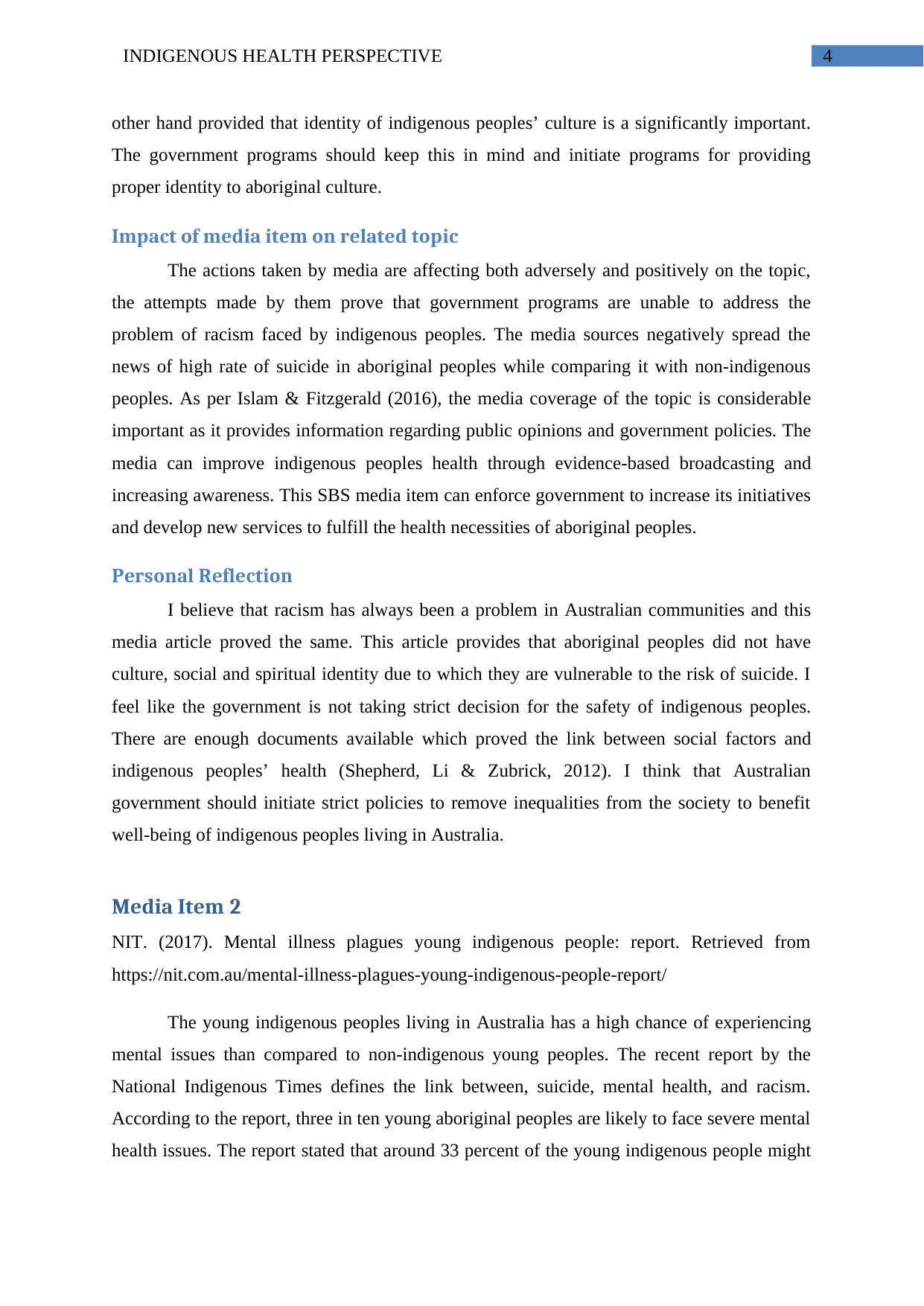
4INDIGENOUS HEALTH PERSPECTIVE
other hand provided that identity of indigenous peoples’ culture is a significantly important.
The government programs should keep this in mind and initiate programs for providing
proper identity to aboriginal culture.
Impact of media item on related topic
The actions taken by media are affecting both adversely and positively on the topic,
the attempts made by them prove that government programs are unable to address the
problem of racism faced by indigenous peoples. The media sources negatively spread the
news of high rate of suicide in aboriginal peoples while comparing it with non-indigenous
peoples. As per Islam & Fitzgerald (2016), the media coverage of the topic is considerable
important as it provides information regarding public opinions and government policies. The
media can improve indigenous peoples health through evidence-based broadcasting and
increasing awareness. This SBS media item can enforce government to increase its initiatives
and develop new services to fulfill the health necessities of aboriginal peoples.
Personal Reflection
I believe that racism has always been a problem in Australian communities and this
media article proved the same. This article provides that aboriginal peoples did not have
culture, social and spiritual identity due to which they are vulnerable to the risk of suicide. I
feel like the government is not taking strict decision for the safety of indigenous peoples.
There are enough documents available which proved the link between social factors and
indigenous peoples’ health (Shepherd, Li & Zubrick, 2012). I think that Australian
government should initiate strict policies to remove inequalities from the society to benefit
well-being of indigenous peoples living in Australia.
Media Item 2
NIT. (2017). Mental illness plagues young indigenous people: report. Retrieved from
https://nit.com.au/mental-illness-plagues-young-indigenous-people-report/
The young indigenous peoples living in Australia has a high chance of experiencing
mental issues than compared to non-indigenous young peoples. The recent report by the
National Indigenous Times defines the link between, suicide, mental health, and racism.
According to the report, three in ten young aboriginal peoples are likely to face severe mental
health issues. The report stated that around 33 percent of the young indigenous people might
other hand provided that identity of indigenous peoples’ culture is a significantly important.
The government programs should keep this in mind and initiate programs for providing
proper identity to aboriginal culture.
Impact of media item on related topic
The actions taken by media are affecting both adversely and positively on the topic,
the attempts made by them prove that government programs are unable to address the
problem of racism faced by indigenous peoples. The media sources negatively spread the
news of high rate of suicide in aboriginal peoples while comparing it with non-indigenous
peoples. As per Islam & Fitzgerald (2016), the media coverage of the topic is considerable
important as it provides information regarding public opinions and government policies. The
media can improve indigenous peoples health through evidence-based broadcasting and
increasing awareness. This SBS media item can enforce government to increase its initiatives
and develop new services to fulfill the health necessities of aboriginal peoples.
Personal Reflection
I believe that racism has always been a problem in Australian communities and this
media article proved the same. This article provides that aboriginal peoples did not have
culture, social and spiritual identity due to which they are vulnerable to the risk of suicide. I
feel like the government is not taking strict decision for the safety of indigenous peoples.
There are enough documents available which proved the link between social factors and
indigenous peoples’ health (Shepherd, Li & Zubrick, 2012). I think that Australian
government should initiate strict policies to remove inequalities from the society to benefit
well-being of indigenous peoples living in Australia.
Media Item 2
NIT. (2017). Mental illness plagues young indigenous people: report. Retrieved from
https://nit.com.au/mental-illness-plagues-young-indigenous-people-report/
The young indigenous peoples living in Australia has a high chance of experiencing
mental issues than compared to non-indigenous young peoples. The recent report by the
National Indigenous Times defines the link between, suicide, mental health, and racism.
According to the report, three in ten young aboriginal peoples are likely to face severe mental
health issues. The report stated that around 33 percent of the young indigenous people might

5INDIGENOUS HEALTH PERSPECTIVE
suffer from mental problems. The study was conducted on peoples between the age of 15 to
19 years, although, few participant were aged ten years as well (NIT, 2017).
The increasing rate of suicide was linked to the trauma faced by peoples due to
racism. As per the National Indigenous Times, the aboriginal peoples in Australia face
disengagement during their education and employment. These factors reduce social well-
being and emotions in young indigenous peoples that lead to substance abuse which
eventually resulted in suicide.
As per the article, a holistic approach is necessary to deal properly with decreasing
levels of social well-being and emotions. There is a requirement of holistic services that focus
on recovery of indigenous peoples by empowering them. The indigenous elders, leaders, and
communities should struggle for the establishment of policies which assist in their resilience
and recovery. There are few methods proposed in the article to address mental health issues
such as telephone hotline facilities, community agency, and magazines. The young
indigenous peoples can take the help and support of their family and friends to reduce their
mental stress. To conclude, the article focuses on the requirement of internet and online
technologies to address the mental health issues faced by young indigenous peoples (NIT,
2017). The online services provided necessary information regarding the treatment,
prevention and diagnosis program.
Relevancy of topics discussed in overall unit
The module 3 topic 2 and module 2 topic 1 are related to this media article. The topics
discuss element of aboriginal culture and influence of colonisation respectively. Module 3
topic 2 provided that there is solid connection between spiritual and physical elements. The
aboriginal peoples are strongly connected with their land and consider it a source of life.
Therefore, social difficulty like unemployment increases the psychological tension and
mental health issues in between indigenous peoples.
Module 2 topic 1 provides that colonisation significantly influences the health and
social status of aboriginal peoples; it adversely impacts on aboriginal health since it is related
to historical trauma. Similarly, racism is a similar and interconnecting phenomenon which
has increased due to effects of colonisation (Paradies, 2016). Both colonisation and racism
resulted in high rate of suicide attempts made by aboriginal peoples.
suffer from mental problems. The study was conducted on peoples between the age of 15 to
19 years, although, few participant were aged ten years as well (NIT, 2017).
The increasing rate of suicide was linked to the trauma faced by peoples due to
racism. As per the National Indigenous Times, the aboriginal peoples in Australia face
disengagement during their education and employment. These factors reduce social well-
being and emotions in young indigenous peoples that lead to substance abuse which
eventually resulted in suicide.
As per the article, a holistic approach is necessary to deal properly with decreasing
levels of social well-being and emotions. There is a requirement of holistic services that focus
on recovery of indigenous peoples by empowering them. The indigenous elders, leaders, and
communities should struggle for the establishment of policies which assist in their resilience
and recovery. There are few methods proposed in the article to address mental health issues
such as telephone hotline facilities, community agency, and magazines. The young
indigenous peoples can take the help and support of their family and friends to reduce their
mental stress. To conclude, the article focuses on the requirement of internet and online
technologies to address the mental health issues faced by young indigenous peoples (NIT,
2017). The online services provided necessary information regarding the treatment,
prevention and diagnosis program.
Relevancy of topics discussed in overall unit
The module 3 topic 2 and module 2 topic 1 are related to this media article. The topics
discuss element of aboriginal culture and influence of colonisation respectively. Module 3
topic 2 provided that there is solid connection between spiritual and physical elements. The
aboriginal peoples are strongly connected with their land and consider it a source of life.
Therefore, social difficulty like unemployment increases the psychological tension and
mental health issues in between indigenous peoples.
Module 2 topic 1 provides that colonisation significantly influences the health and
social status of aboriginal peoples; it adversely impacts on aboriginal health since it is related
to historical trauma. Similarly, racism is a similar and interconnecting phenomenon which
has increased due to effects of colonisation (Paradies, 2016). Both colonisation and racism
resulted in high rate of suicide attempts made by aboriginal peoples.
⊘ This is a preview!⊘
Do you want full access?
Subscribe today to unlock all pages.

Trusted by 1+ million students worldwide
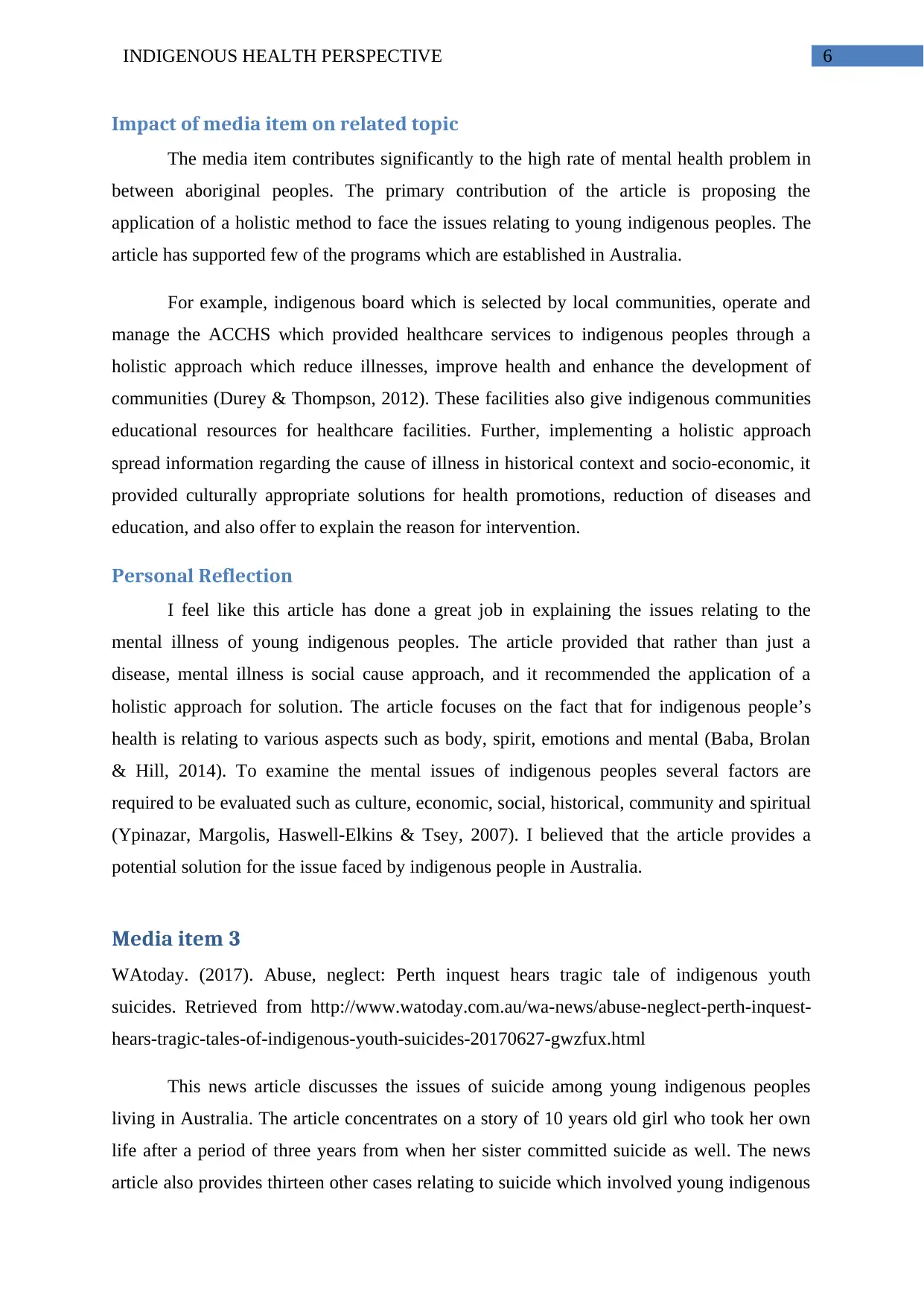
6INDIGENOUS HEALTH PERSPECTIVE
Impact of media item on related topic
The media item contributes significantly to the high rate of mental health problem in
between aboriginal peoples. The primary contribution of the article is proposing the
application of a holistic method to face the issues relating to young indigenous peoples. The
article has supported few of the programs which are established in Australia.
For example, indigenous board which is selected by local communities, operate and
manage the ACCHS which provided healthcare services to indigenous peoples through a
holistic approach which reduce illnesses, improve health and enhance the development of
communities (Durey & Thompson, 2012). These facilities also give indigenous communities
educational resources for healthcare facilities. Further, implementing a holistic approach
spread information regarding the cause of illness in historical context and socio-economic, it
provided culturally appropriate solutions for health promotions, reduction of diseases and
education, and also offer to explain the reason for intervention.
Personal Reflection
I feel like this article has done a great job in explaining the issues relating to the
mental illness of young indigenous peoples. The article provided that rather than just a
disease, mental illness is social cause approach, and it recommended the application of a
holistic approach for solution. The article focuses on the fact that for indigenous people’s
health is relating to various aspects such as body, spirit, emotions and mental (Baba, Brolan
& Hill, 2014). To examine the mental issues of indigenous peoples several factors are
required to be evaluated such as culture, economic, social, historical, community and spiritual
(Ypinazar, Margolis, Haswell-Elkins & Tsey, 2007). I believed that the article provides a
potential solution for the issue faced by indigenous people in Australia.
Media item 3
WAtoday. (2017). Abuse, neglect: Perth inquest hears tragic tale of indigenous youth
suicides. Retrieved from http://www.watoday.com.au/wa-news/abuse-neglect-perth-inquest-
hears-tragic-tales-of-indigenous-youth-suicides-20170627-gwzfux.html
This news article discusses the issues of suicide among young indigenous peoples
living in Australia. The article concentrates on a story of 10 years old girl who took her own
life after a period of three years from when her sister committed suicide as well. The news
article also provides thirteen other cases relating to suicide which involved young indigenous
Impact of media item on related topic
The media item contributes significantly to the high rate of mental health problem in
between aboriginal peoples. The primary contribution of the article is proposing the
application of a holistic method to face the issues relating to young indigenous peoples. The
article has supported few of the programs which are established in Australia.
For example, indigenous board which is selected by local communities, operate and
manage the ACCHS which provided healthcare services to indigenous peoples through a
holistic approach which reduce illnesses, improve health and enhance the development of
communities (Durey & Thompson, 2012). These facilities also give indigenous communities
educational resources for healthcare facilities. Further, implementing a holistic approach
spread information regarding the cause of illness in historical context and socio-economic, it
provided culturally appropriate solutions for health promotions, reduction of diseases and
education, and also offer to explain the reason for intervention.
Personal Reflection
I feel like this article has done a great job in explaining the issues relating to the
mental illness of young indigenous peoples. The article provided that rather than just a
disease, mental illness is social cause approach, and it recommended the application of a
holistic approach for solution. The article focuses on the fact that for indigenous people’s
health is relating to various aspects such as body, spirit, emotions and mental (Baba, Brolan
& Hill, 2014). To examine the mental issues of indigenous peoples several factors are
required to be evaluated such as culture, economic, social, historical, community and spiritual
(Ypinazar, Margolis, Haswell-Elkins & Tsey, 2007). I believed that the article provides a
potential solution for the issue faced by indigenous people in Australia.
Media item 3
WAtoday. (2017). Abuse, neglect: Perth inquest hears tragic tale of indigenous youth
suicides. Retrieved from http://www.watoday.com.au/wa-news/abuse-neglect-perth-inquest-
hears-tragic-tales-of-indigenous-youth-suicides-20170627-gwzfux.html
This news article discusses the issues of suicide among young indigenous peoples
living in Australia. The article concentrates on a story of 10 years old girl who took her own
life after a period of three years from when her sister committed suicide as well. The news
article also provides thirteen other cases relating to suicide which involved young indigenous
Paraphrase This Document
Need a fresh take? Get an instant paraphrase of this document with our AI Paraphraser
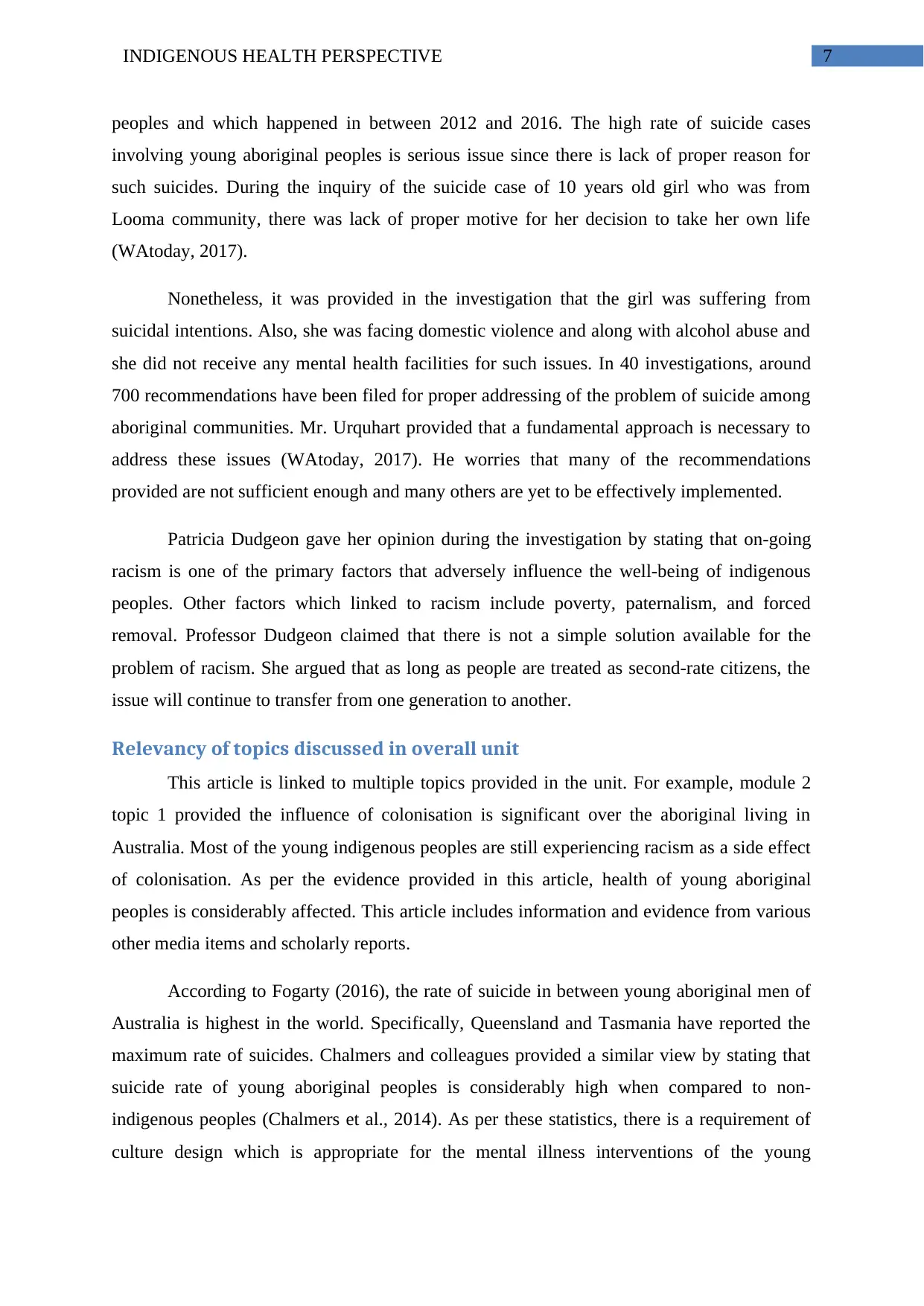
7INDIGENOUS HEALTH PERSPECTIVE
peoples and which happened in between 2012 and 2016. The high rate of suicide cases
involving young aboriginal peoples is serious issue since there is lack of proper reason for
such suicides. During the inquiry of the suicide case of 10 years old girl who was from
Looma community, there was lack of proper motive for her decision to take her own life
(WAtoday, 2017).
Nonetheless, it was provided in the investigation that the girl was suffering from
suicidal intentions. Also, she was facing domestic violence and along with alcohol abuse and
she did not receive any mental health facilities for such issues. In 40 investigations, around
700 recommendations have been filed for proper addressing of the problem of suicide among
aboriginal communities. Mr. Urquhart provided that a fundamental approach is necessary to
address these issues (WAtoday, 2017). He worries that many of the recommendations
provided are not sufficient enough and many others are yet to be effectively implemented.
Patricia Dudgeon gave her opinion during the investigation by stating that on-going
racism is one of the primary factors that adversely influence the well-being of indigenous
peoples. Other factors which linked to racism include poverty, paternalism, and forced
removal. Professor Dudgeon claimed that there is not a simple solution available for the
problem of racism. She argued that as long as people are treated as second-rate citizens, the
issue will continue to transfer from one generation to another.
Relevancy of topics discussed in overall unit
This article is linked to multiple topics provided in the unit. For example, module 2
topic 1 provided the influence of colonisation is significant over the aboriginal living in
Australia. Most of the young indigenous peoples are still experiencing racism as a side effect
of colonisation. As per the evidence provided in this article, health of young aboriginal
peoples is considerably affected. This article includes information and evidence from various
other media items and scholarly reports.
According to Fogarty (2016), the rate of suicide in between young aboriginal men of
Australia is highest in the world. Specifically, Queensland and Tasmania have reported the
maximum rate of suicides. Chalmers and colleagues provided a similar view by stating that
suicide rate of young aboriginal peoples is considerably high when compared to non-
indigenous peoples (Chalmers et al., 2014). As per these statistics, there is a requirement of
culture design which is appropriate for the mental illness interventions of the young
peoples and which happened in between 2012 and 2016. The high rate of suicide cases
involving young aboriginal peoples is serious issue since there is lack of proper reason for
such suicides. During the inquiry of the suicide case of 10 years old girl who was from
Looma community, there was lack of proper motive for her decision to take her own life
(WAtoday, 2017).
Nonetheless, it was provided in the investigation that the girl was suffering from
suicidal intentions. Also, she was facing domestic violence and along with alcohol abuse and
she did not receive any mental health facilities for such issues. In 40 investigations, around
700 recommendations have been filed for proper addressing of the problem of suicide among
aboriginal communities. Mr. Urquhart provided that a fundamental approach is necessary to
address these issues (WAtoday, 2017). He worries that many of the recommendations
provided are not sufficient enough and many others are yet to be effectively implemented.
Patricia Dudgeon gave her opinion during the investigation by stating that on-going
racism is one of the primary factors that adversely influence the well-being of indigenous
peoples. Other factors which linked to racism include poverty, paternalism, and forced
removal. Professor Dudgeon claimed that there is not a simple solution available for the
problem of racism. She argued that as long as people are treated as second-rate citizens, the
issue will continue to transfer from one generation to another.
Relevancy of topics discussed in overall unit
This article is linked to multiple topics provided in the unit. For example, module 2
topic 1 provided the influence of colonisation is significant over the aboriginal living in
Australia. Most of the young indigenous peoples are still experiencing racism as a side effect
of colonisation. As per the evidence provided in this article, health of young aboriginal
peoples is considerably affected. This article includes information and evidence from various
other media items and scholarly reports.
According to Fogarty (2016), the rate of suicide in between young aboriginal men of
Australia is highest in the world. Specifically, Queensland and Tasmania have reported the
maximum rate of suicides. Chalmers and colleagues provided a similar view by stating that
suicide rate of young aboriginal peoples is considerably high when compared to non-
indigenous peoples (Chalmers et al., 2014). As per these statistics, there is a requirement of
culture design which is appropriate for the mental illness interventions of the young

8INDIGENOUS HEALTH PERSPECTIVE
aboriginal peoples in Australia. In this case, module 3 topic 1 is related which focus on
designing culturally appropriate facilities.
Impact of media item on related topic
This article provided necessary information regarding the related issues; it focuses on
the reason of young aboriginal people for suicide. According to the article, the high suicide
rate among aboriginal people is caused due to mental health issues. Many adolescents who
committed suicide were suffering from mental illnesses at some point in their life, and failure
to address such issues were the reason for their suicide.
Other than mental health issues, there are several other issues which contributed to the
suicide rate of aboriginal peoples such as alienation, the stress of social disadvantages,
racism, and exclusion from society (Department of Health, 2013). Additionally, the article
has reported that rate of suicide is higher in remote areas; a large number of young
indigenous peoples who committed suicide were living in rural areas (Soole, Kolves, & De
Leo, 2014). The evidence also provided that domestic violence and substance abuse, mainly
alcohol, are linked to the high rate of suicide among young indigenous peoples.
Personal reflection
I think that early detection of serious mental illness syndromes in young aboriginal
peoples in Australia is significantly important. By detecting risks factors at an early stage
such as substance abuse can help indigenous adolescence tackle their mental issues and
reduce intention of suicide. I believe that proper study of mental health issues’ patterns can
provide necessary information which can be utilised in order to prevent the cause of suicidal
intentions. I think that it is easier to remove an illness if the disease or its causes are reliably
detected (Costello, 2016).
Media item 4
Haggan, M. (2017). Closing the gap is vital. Retrieved from https://ajp.com.au/news/closing-
gap-vital/
According to Haggan (2017), the government is devoted to positively influence the
health and social status of aboriginal peoples in Australia. However, he provided that
renewed initiative and efforts are necessary to bridge the gap between indigenous peoples and
other communities of Australia. It is necessary that renewed approach specifically integrated
aboriginal peoples in Australia. In this case, module 3 topic 1 is related which focus on
designing culturally appropriate facilities.
Impact of media item on related topic
This article provided necessary information regarding the related issues; it focuses on
the reason of young aboriginal people for suicide. According to the article, the high suicide
rate among aboriginal people is caused due to mental health issues. Many adolescents who
committed suicide were suffering from mental illnesses at some point in their life, and failure
to address such issues were the reason for their suicide.
Other than mental health issues, there are several other issues which contributed to the
suicide rate of aboriginal peoples such as alienation, the stress of social disadvantages,
racism, and exclusion from society (Department of Health, 2013). Additionally, the article
has reported that rate of suicide is higher in remote areas; a large number of young
indigenous peoples who committed suicide were living in rural areas (Soole, Kolves, & De
Leo, 2014). The evidence also provided that domestic violence and substance abuse, mainly
alcohol, are linked to the high rate of suicide among young indigenous peoples.
Personal reflection
I think that early detection of serious mental illness syndromes in young aboriginal
peoples in Australia is significantly important. By detecting risks factors at an early stage
such as substance abuse can help indigenous adolescence tackle their mental issues and
reduce intention of suicide. I believe that proper study of mental health issues’ patterns can
provide necessary information which can be utilised in order to prevent the cause of suicidal
intentions. I think that it is easier to remove an illness if the disease or its causes are reliably
detected (Costello, 2016).
Media item 4
Haggan, M. (2017). Closing the gap is vital. Retrieved from https://ajp.com.au/news/closing-
gap-vital/
According to Haggan (2017), the government is devoted to positively influence the
health and social status of aboriginal peoples in Australia. However, he provided that
renewed initiative and efforts are necessary to bridge the gap between indigenous peoples and
other communities of Australia. It is necessary that renewed approach specifically integrated
⊘ This is a preview!⊘
Do you want full access?
Subscribe today to unlock all pages.

Trusted by 1+ million students worldwide
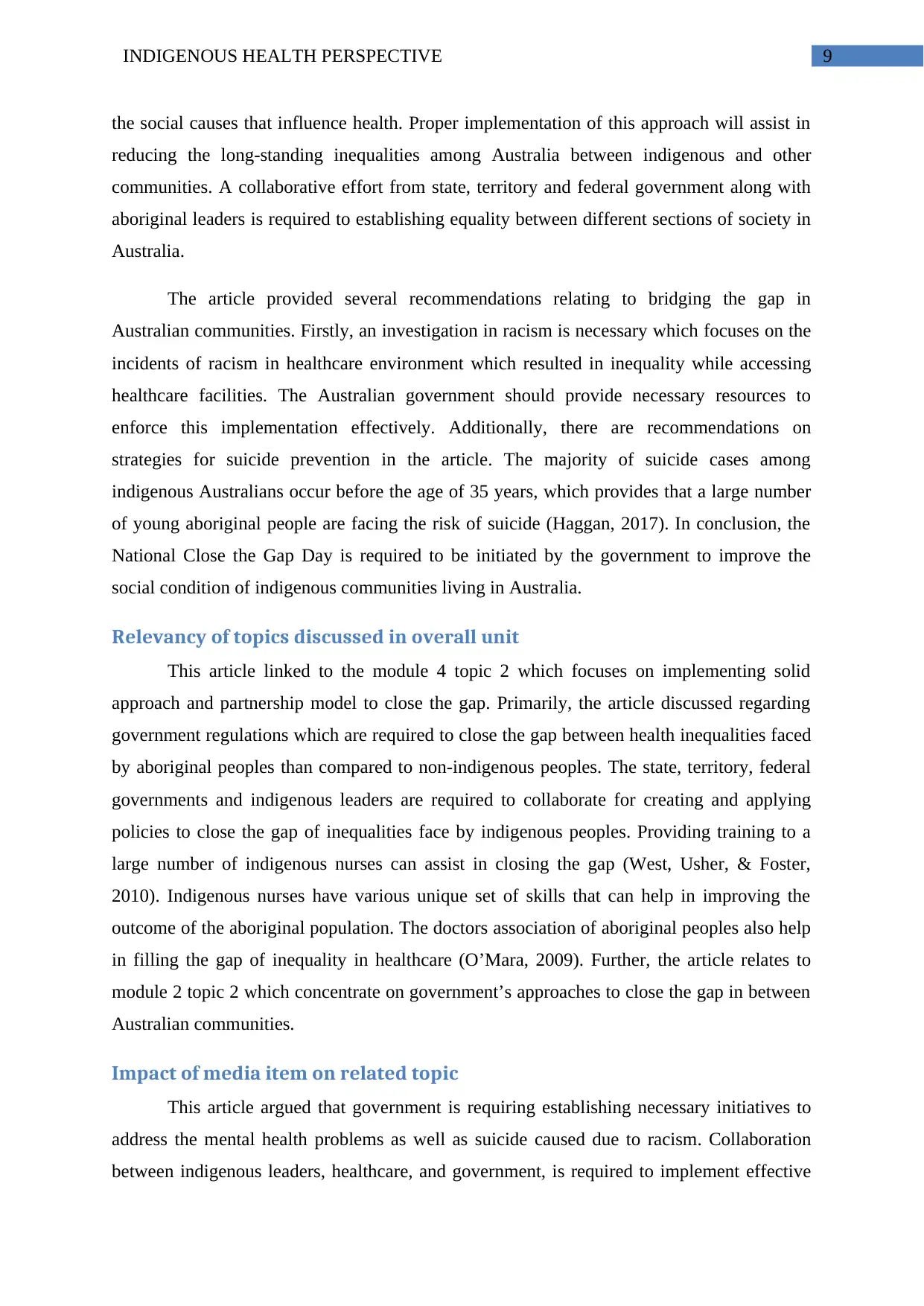
9INDIGENOUS HEALTH PERSPECTIVE
the social causes that influence health. Proper implementation of this approach will assist in
reducing the long-standing inequalities among Australia between indigenous and other
communities. A collaborative effort from state, territory and federal government along with
aboriginal leaders is required to establishing equality between different sections of society in
Australia.
The article provided several recommendations relating to bridging the gap in
Australian communities. Firstly, an investigation in racism is necessary which focuses on the
incidents of racism in healthcare environment which resulted in inequality while accessing
healthcare facilities. The Australian government should provide necessary resources to
enforce this implementation effectively. Additionally, there are recommendations on
strategies for suicide prevention in the article. The majority of suicide cases among
indigenous Australians occur before the age of 35 years, which provides that a large number
of young aboriginal people are facing the risk of suicide (Haggan, 2017). In conclusion, the
National Close the Gap Day is required to be initiated by the government to improve the
social condition of indigenous communities living in Australia.
Relevancy of topics discussed in overall unit
This article linked to the module 4 topic 2 which focuses on implementing solid
approach and partnership model to close the gap. Primarily, the article discussed regarding
government regulations which are required to close the gap between health inequalities faced
by aboriginal peoples than compared to non-indigenous peoples. The state, territory, federal
governments and indigenous leaders are required to collaborate for creating and applying
policies to close the gap of inequalities face by indigenous peoples. Providing training to a
large number of indigenous nurses can assist in closing the gap (West, Usher, & Foster,
2010). Indigenous nurses have various unique set of skills that can help in improving the
outcome of the aboriginal population. The doctors association of aboriginal peoples also help
in filling the gap of inequality in healthcare (O’Mara, 2009). Further, the article relates to
module 2 topic 2 which concentrate on government’s approaches to close the gap in between
Australian communities.
Impact of media item on related topic
This article argued that government is requiring establishing necessary initiatives to
address the mental health problems as well as suicide caused due to racism. Collaboration
between indigenous leaders, healthcare, and government, is required to implement effective
the social causes that influence health. Proper implementation of this approach will assist in
reducing the long-standing inequalities among Australia between indigenous and other
communities. A collaborative effort from state, territory and federal government along with
aboriginal leaders is required to establishing equality between different sections of society in
Australia.
The article provided several recommendations relating to bridging the gap in
Australian communities. Firstly, an investigation in racism is necessary which focuses on the
incidents of racism in healthcare environment which resulted in inequality while accessing
healthcare facilities. The Australian government should provide necessary resources to
enforce this implementation effectively. Additionally, there are recommendations on
strategies for suicide prevention in the article. The majority of suicide cases among
indigenous Australians occur before the age of 35 years, which provides that a large number
of young aboriginal people are facing the risk of suicide (Haggan, 2017). In conclusion, the
National Close the Gap Day is required to be initiated by the government to improve the
social condition of indigenous communities living in Australia.
Relevancy of topics discussed in overall unit
This article linked to the module 4 topic 2 which focuses on implementing solid
approach and partnership model to close the gap. Primarily, the article discussed regarding
government regulations which are required to close the gap between health inequalities faced
by aboriginal peoples than compared to non-indigenous peoples. The state, territory, federal
governments and indigenous leaders are required to collaborate for creating and applying
policies to close the gap of inequalities face by indigenous peoples. Providing training to a
large number of indigenous nurses can assist in closing the gap (West, Usher, & Foster,
2010). Indigenous nurses have various unique set of skills that can help in improving the
outcome of the aboriginal population. The doctors association of aboriginal peoples also help
in filling the gap of inequality in healthcare (O’Mara, 2009). Further, the article relates to
module 2 topic 2 which concentrate on government’s approaches to close the gap in between
Australian communities.
Impact of media item on related topic
This article argued that government is requiring establishing necessary initiatives to
address the mental health problems as well as suicide caused due to racism. Collaboration
between indigenous leaders, healthcare, and government, is required to implement effective
Paraphrase This Document
Need a fresh take? Get an instant paraphrase of this document with our AI Paraphraser
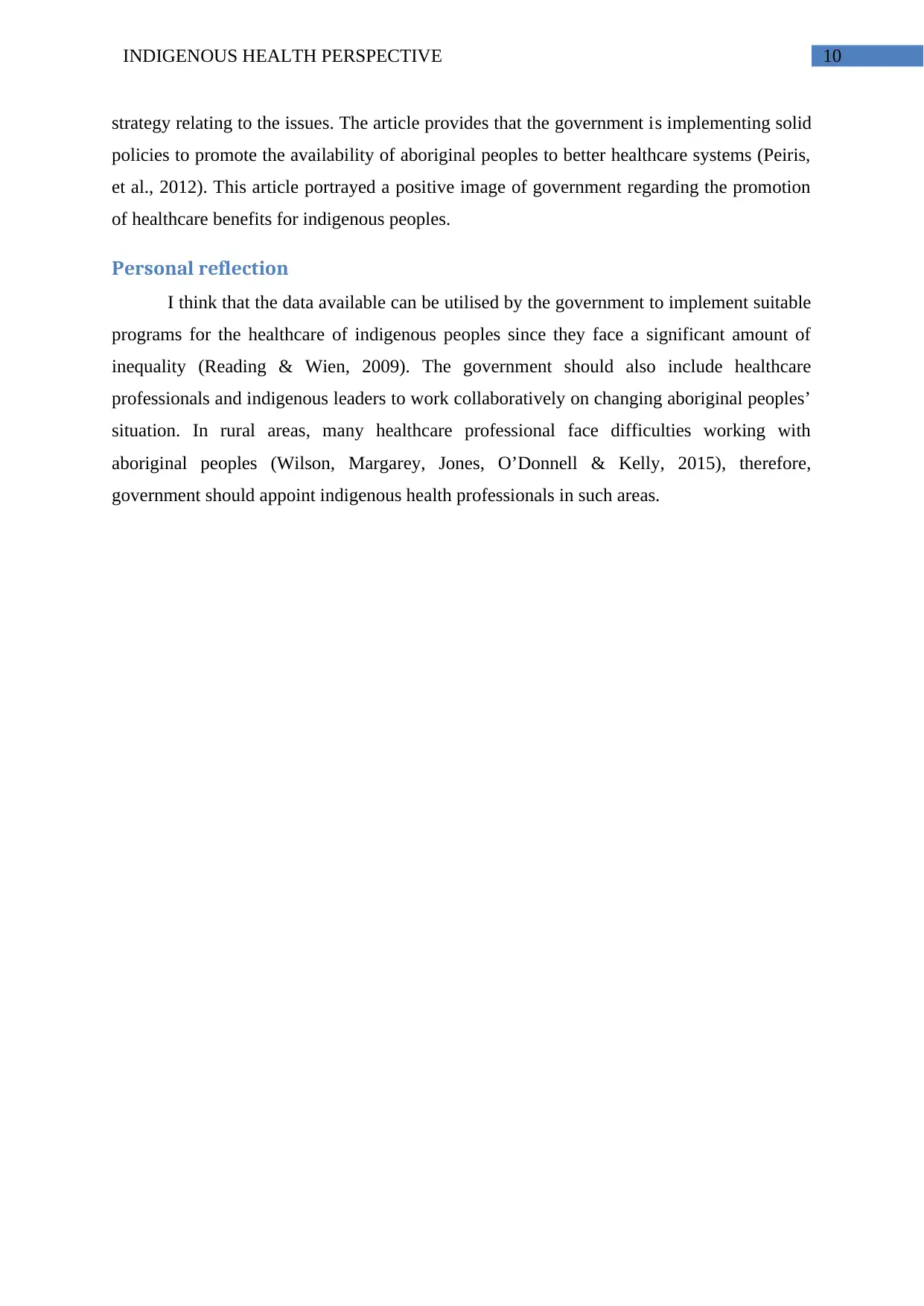
10INDIGENOUS HEALTH PERSPECTIVE
strategy relating to the issues. The article provides that the government is implementing solid
policies to promote the availability of aboriginal peoples to better healthcare systems (Peiris,
et al., 2012). This article portrayed a positive image of government regarding the promotion
of healthcare benefits for indigenous peoples.
Personal reflection
I think that the data available can be utilised by the government to implement suitable
programs for the healthcare of indigenous peoples since they face a significant amount of
inequality (Reading & Wien, 2009). The government should also include healthcare
professionals and indigenous leaders to work collaboratively on changing aboriginal peoples’
situation. In rural areas, many healthcare professional face difficulties working with
aboriginal peoples (Wilson, Margarey, Jones, O’Donnell & Kelly, 2015), therefore,
government should appoint indigenous health professionals in such areas.
strategy relating to the issues. The article provides that the government is implementing solid
policies to promote the availability of aboriginal peoples to better healthcare systems (Peiris,
et al., 2012). This article portrayed a positive image of government regarding the promotion
of healthcare benefits for indigenous peoples.
Personal reflection
I think that the data available can be utilised by the government to implement suitable
programs for the healthcare of indigenous peoples since they face a significant amount of
inequality (Reading & Wien, 2009). The government should also include healthcare
professionals and indigenous leaders to work collaboratively on changing aboriginal peoples’
situation. In rural areas, many healthcare professional face difficulties working with
aboriginal peoples (Wilson, Margarey, Jones, O’Donnell & Kelly, 2015), therefore,
government should appoint indigenous health professionals in such areas.
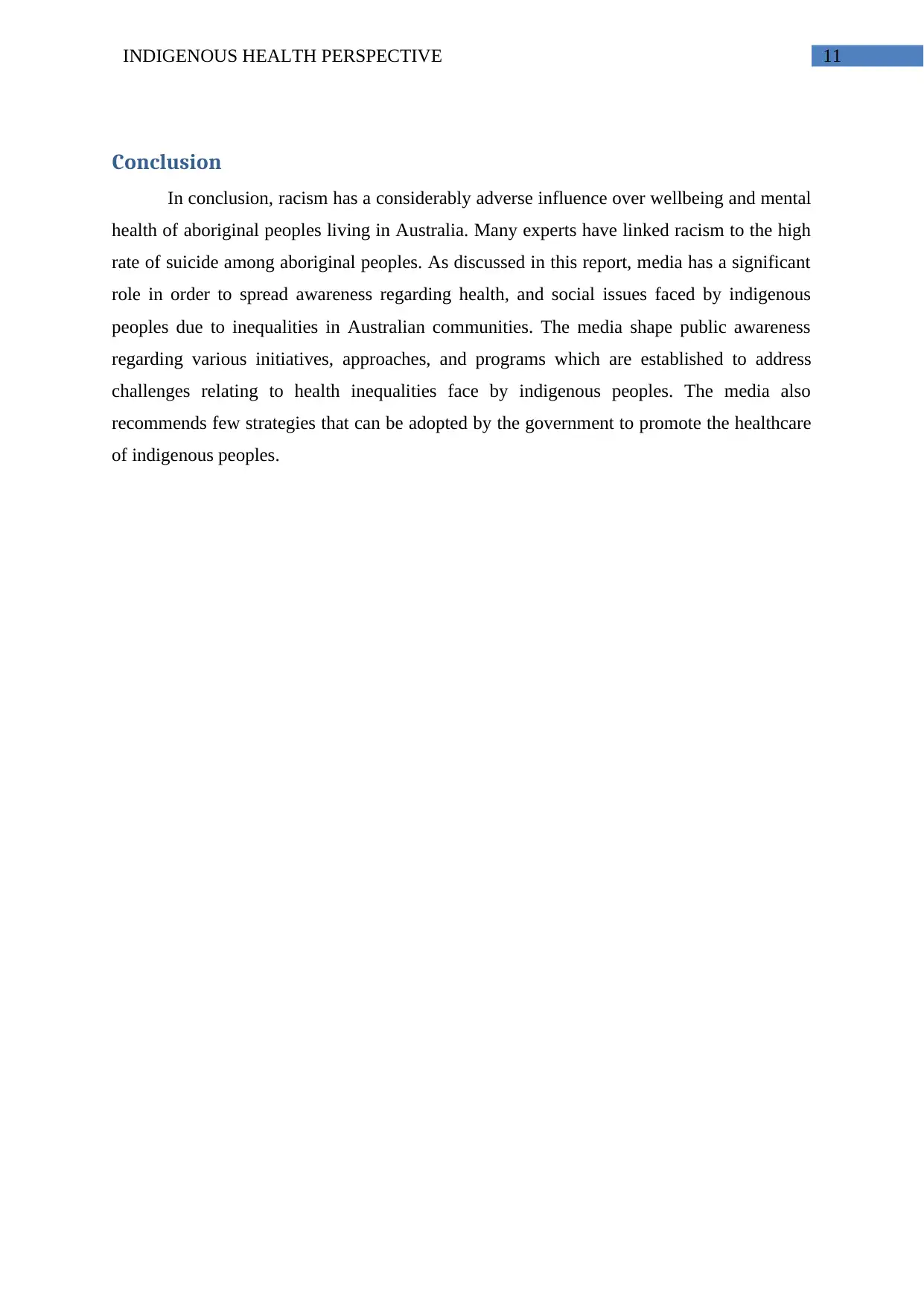
11INDIGENOUS HEALTH PERSPECTIVE
Conclusion
In conclusion, racism has a considerably adverse influence over wellbeing and mental
health of aboriginal peoples living in Australia. Many experts have linked racism to the high
rate of suicide among aboriginal peoples. As discussed in this report, media has a significant
role in order to spread awareness regarding health, and social issues faced by indigenous
peoples due to inequalities in Australian communities. The media shape public awareness
regarding various initiatives, approaches, and programs which are established to address
challenges relating to health inequalities face by indigenous peoples. The media also
recommends few strategies that can be adopted by the government to promote the healthcare
of indigenous peoples.
Conclusion
In conclusion, racism has a considerably adverse influence over wellbeing and mental
health of aboriginal peoples living in Australia. Many experts have linked racism to the high
rate of suicide among aboriginal peoples. As discussed in this report, media has a significant
role in order to spread awareness regarding health, and social issues faced by indigenous
peoples due to inequalities in Australian communities. The media shape public awareness
regarding various initiatives, approaches, and programs which are established to address
challenges relating to health inequalities face by indigenous peoples. The media also
recommends few strategies that can be adopted by the government to promote the healthcare
of indigenous peoples.
⊘ This is a preview!⊘
Do you want full access?
Subscribe today to unlock all pages.

Trusted by 1+ million students worldwide
1 out of 15
Related Documents
Your All-in-One AI-Powered Toolkit for Academic Success.
+13062052269
info@desklib.com
Available 24*7 on WhatsApp / Email
![[object Object]](/_next/static/media/star-bottom.7253800d.svg)
Unlock your academic potential
Copyright © 2020–2025 A2Z Services. All Rights Reserved. Developed and managed by ZUCOL.





